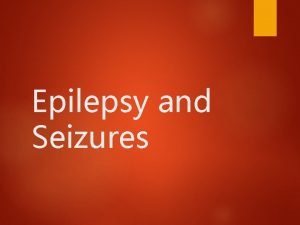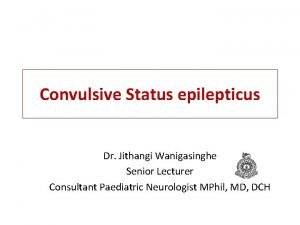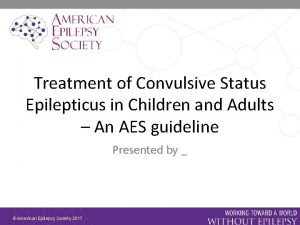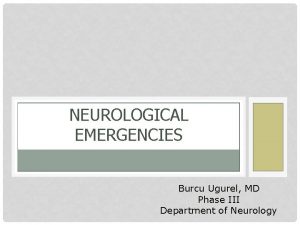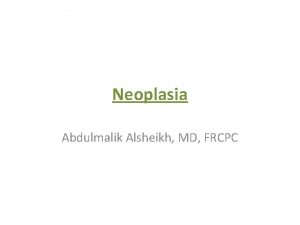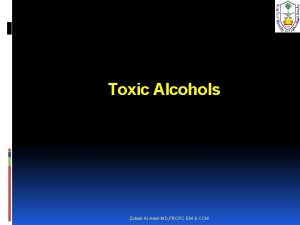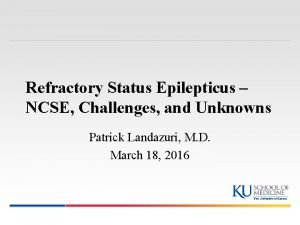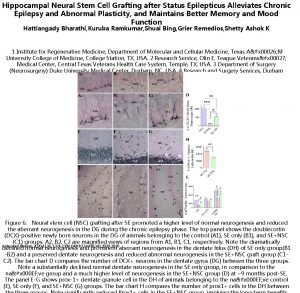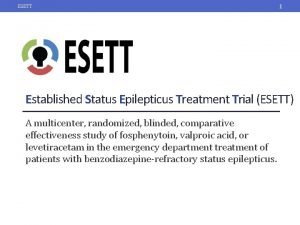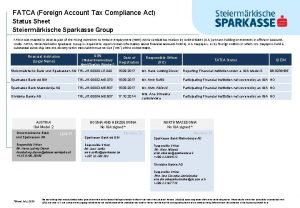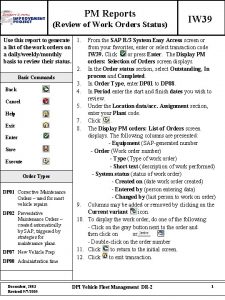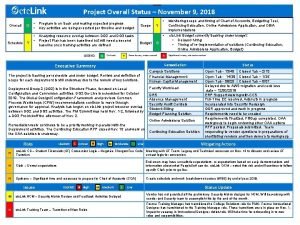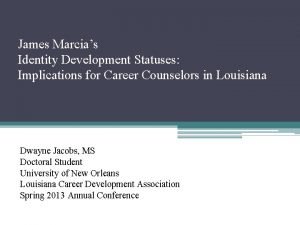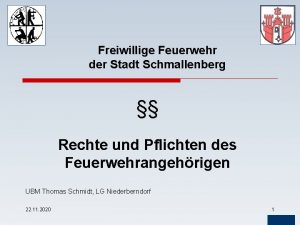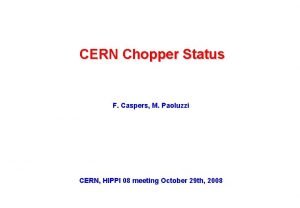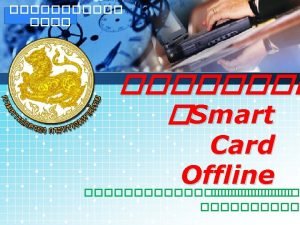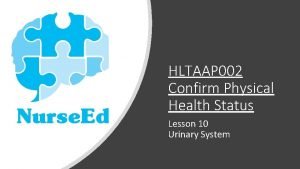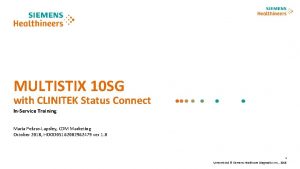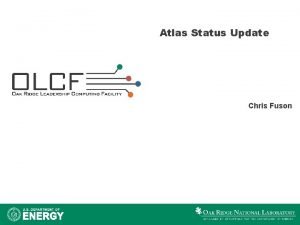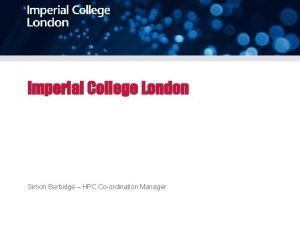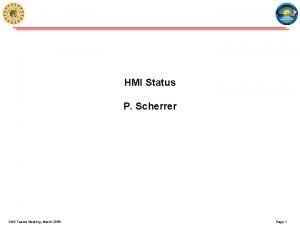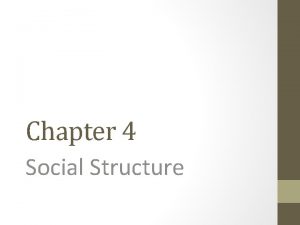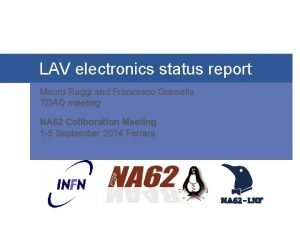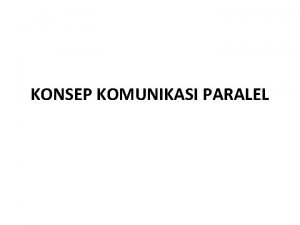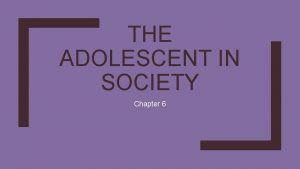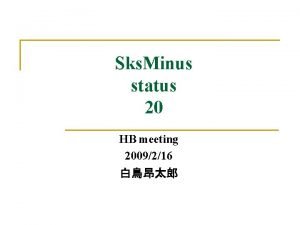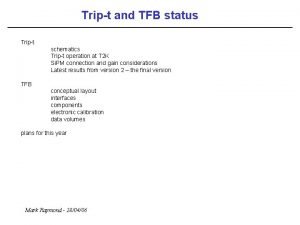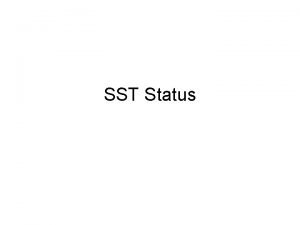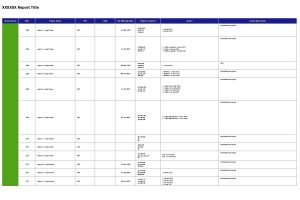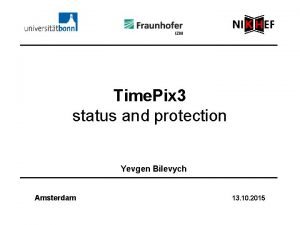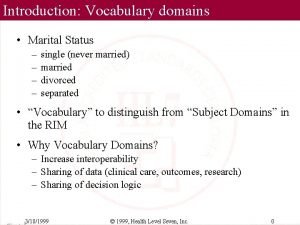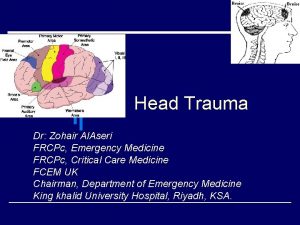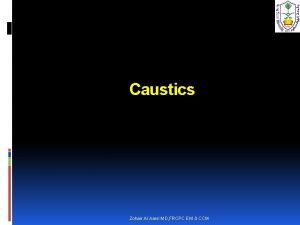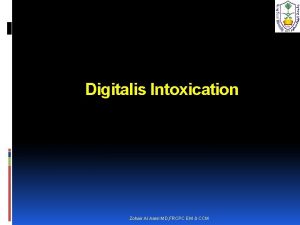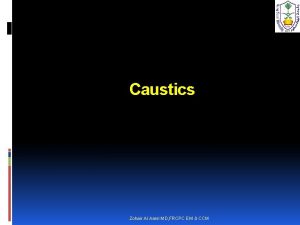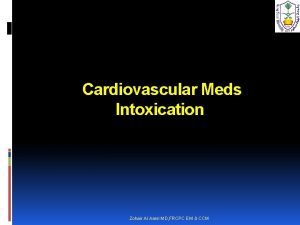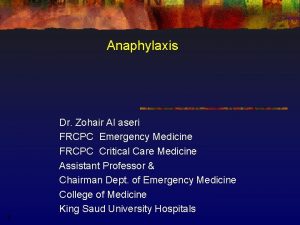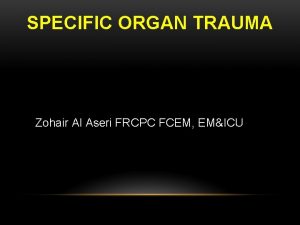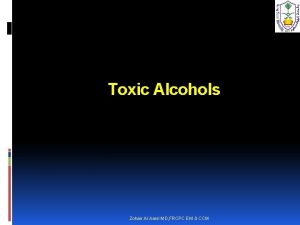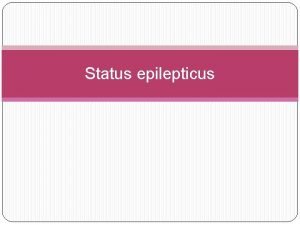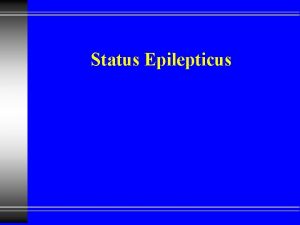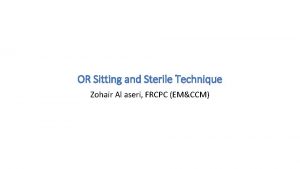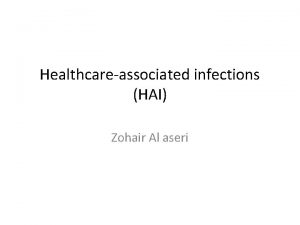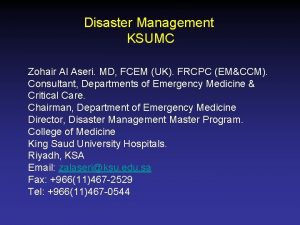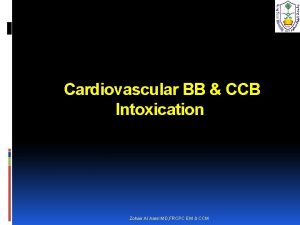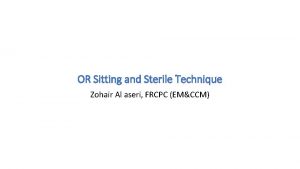Status Epilepticus Zohair A Al Aseri MD FRCPC



































































- Slides: 67

Status Epilepticus Zohair A. Al Aseri MD, FRCPC EM & CCM Associate Professor , DEM and CCD College of Medicine King Saud University Consultant Emergency Medicine and Intensivist King Saud University Medical City Zohair Al Aseri MD, FRCPC EM & CCM

Status Epilepticus References 1. Evidence-Based Guideline: Treatment of Convulsive Status Epilepticus in Children and Adults: Report of the Guideline Committee of the American Epilepsy Society. Tracy Glauser et al. / Epilepsy Current. 2. Challenges in the treatment of convulsive status epilepticus. G. Zaccara et al. / Seizure 47 (2017) 17– 24 3. 25 years of advances in the definition, classification and treatment of status epilepticus. E. Trinka, R. Ka lvia inen / Seizure 44 (2017) 65– 73 4. Billington, M. ; Kandalaft, O. R. ; Aisiku, I. P. Adult Status Epilepticus: A Review of the Prehospital and Emergency Department Management. J. Clin. Med. 2016, 5, 74. 5. https: //emcrit. org/pulmcrit/rapid-sequence-termination-rst-ofstatus-epilepticus/ Zohair Al Aseri MD, FRCPC EM & CCM

Status Epilepticus Objectives Introduction & Definitions Causes Investigation Evidence-Based treatment options Algorithm Conclusion Zohair Al Aseri MD, FRCPC EM & CCM

Introduction High morbidity and mortality. SE is a manifestation of a disease. It is mandatory to look for an underlying cause Prolonged Seizure Higher rate of complications including permanent neuronal damage De. Lorenzo R. J. , Hauser W. A. , Towne A. R. , et al: A prospective, population-based epidemiologic study of status epilepticus in Richmond, Virginia. Neurology 46. (4): 1029 -1035. 1996; Zohair Al Aseri MD, FRCPC EM & CCM

Status Epilepticus New Definitions SE: Refractory SE RSE: (ILAE Task force), 2015 Seizure that is prolonged after initiation of mechanisms to terminate the seizure within 5 minutes Trinka E. , Cock H. , Hesdorffer D. A definition and classification of status epilepticus— Report of the ILAE Task Force on Classification of Status Epilepticus. Epilepsia. 2015; 56: 1515– 1523. doi: 10. 1111/epi. 13121 SE that persists despite adequate administration of benzo. and at least one antiepileptic drug Holtkamp M: Treatment strategies for refractory status epilepticus. Curr Opin Crit Care 17. 94 -100. 2011 Novy J, Logroscino G, Rossetti AO: Refractory status epilepticus: a prospective observational study. Epilepsia 51. 251 -256. 2010 Zohair Al Aseri MD, FRCPC EM & CCM

Wahts wrong with this algorithm Why there is no mentioning about seizure termination with benzo in the 1 st 5 minutes of SE management? ? Zohair Al Aseri MD, FRCPC EM & CCM What about the definition

Billington, M. ; Kandalaft, O. R. ; Aisiku, I. P. Adult Status Epilepticus: A Review of the Prehospital and Emergency Department Management. J. Clin. Med. 2016, 5, 74. Zohair Al Aseri MD, FRCPC EM & CCM

Status epilepticus presents in several forms: Convulsive status epilepticus repeated generalized tonicclonic seizures with persistent postictal depression of neurologic function between seizures Nonconvulsive status seizures produce a continuous or fluctuating “epileptic twilight” state epilepticus Repeated partial seizures Zohair Al Aseri MD, FRCPC EM & CCM focal motor signs, focal sensory symptoms, or focal impairment of function (e. g aphasia) not associated with altered awareness (epilepsia partialis continua).

VASCULAR STROKE SAH SUB OR EPIDURAL HEMATOMA VASCULITIS Toxic Cocaine Tricyclics Anticholinerg. Isoniazid Withdrawal Causes of SE TUMORS ECLAMPSIA Zohair Al Aseri MD, FRCPC EM & CCM INFECTIOUS MENINGITIS ENCEPHALITIS BRAIN ABSCESS METABOLIC HYPONATREMIA HYPOGLYCEMIA HYPOCALCEMIA HYPO MG

Status Epilepticus Initial stabilization Simultaneously: Oxygenation and ventilation IV access Antiepileptic Glucocheck Diagnostic studies Thiamine, 100 mg for alcohol abuse pt. Empiric AB, ceftriaxone, 1 to 2 g IV and vancomycin, 1 g IV if you suspect CNS infection. Zohair Al Aseri MD, FRCPC EM & CCM

Status Epilepticus Initial stabilization if intubation needed: RSI Paralytic agents will stop the motor activity but not the abnormal neuronal firing SE. Use ketamine and propofol Zohair Al Aseri MD, FRCPC EM & CCM

Ketamine for the treatment of refractory status epilepticus. Y. Fang, X. Wang / Seizure 30 (2015) 14– 20 Zohair Al Aseri MD, FRCPC EM & CCM

Zohair Al Aseri MD, FRCPC EM & CCM https: //emcrit. org/pulmcrit/ rapid-sequencetermination-rst-of-statusepilepticus/

Status Epilepticus Diagnostic testing Laboratory Studies Serum electrolytes Ca, Mg Glucose Renal and Liver function testing Antiepileptic drug levels Toxicology screen Zohair Al Aseri MD, FRCPC EM & CCM

Status Epilepticus Diagnostic testing Neuroimaging A noncontrast Brain CT should be considered for all SE patients once they have been stabilized. Lumbar Puncture if you suspect CNS infection Empiric antibiotic or antiviral therapy Obtain CT Zohair Al Aseri MD, FRCPC EM & CCM

Status Epilepticus Diagnostic testing EEG Monitoring Nonconvulsive SE. Comatose after generalized seizure Paralytics where neuro examination is impossible Zohair Al Aseri MD, FRCPC EM & CCM

Treatment Anticonvulsant selection depends on “efficacy” Ability to stop convulsive SE. “tolerability” “incidence, severity and impact” of adverse effects. “effectiveness” Few RCT that demonstrate Both efficacy and tolerability. superiority of one agent over another. “safety” life-threatening adverse events. Zohair Al Aseri MD, FRCPC EM & CCM

Status Epilepticus Treatment Benzodiazepines The first drugs of choice for SE. Diazepam (0. 2 mg/kg given at 5 mg/min) Lorazepam (0. 1 mg/kg given at 2 -4 mg/min) Zohair Al Aseri MD, FRCPC EM & CCM

Basic principles of SE treatment Benzodiazepines are the only evidence-based treatment, as shown in three trials and a Cochrane review. • Treiman DM, Meyers PD, Walton NY, et al: A comparison of four treatments for generalized convulsive status epilepticus. Veterans Affairs Status Epilepticus Cooperative Study Group. N Engl J Med 339. 792 -798. 1998; • Alldredge BK, Gelb AM, Isaacs SM, et al: A comparison of lorazepam, diazepam, and placebo for the treatment of out-of-hospital status epilepticus. N Engl J Med 345. 631 -637. 2001; • Leppik IE, Derivan AT, Homan RW, Walker J, Ramsay RE, Patrick B: Double-blind study of lorazepam and diazepam in status epilepticus. JAMA 249. 14521454. 1983; • Prasad K, Al-Roomi K, Krishnan PR, Sequeira R: Anticonvulsant therapy for status epilepticus. Cochrane Database Syst Rev 4. 2005; CD 003723. Zohair Al Aseri MD, FRCPC EM & CCM

Status Epilepticus Treatment Benzodiazepines Study of out-of-hospital treatment of seizures lorazepam vs diazepam. Seizure activity terminated in 60% of the lorazepam-treated patients 43% of diazepam-treated patients 21% of patients who received placebo Alldredge B. K. , Gelb A. M. , Isaacs S. M. , et al: A comparison of lorazepam, diazepam, and placebo for the treatment of out-of-hospital status epilepticus. N Engl J Med 345. (9): 631 -637. 2001; Zohair Al Aseri MD, FRCPC EM & CCM

Status Epilepticus Treatment Benzodiazepines When IV is not available alternative routes must be considered. Both diazepam and lorazepam can be given rectally Appleton R. , Sweeney A. , Choonara I. , et al: Lorazepam versus diazepam in the acute treatment of epileptic seizures and status epilepticus. Dev Med Child Neurol 37. (8): 682 -688. 1995; Chamberlain J. M. , Altieri M. A. , Futterman C. , et al: A prospective, randomized study comparing intramuscular midazolam with intravenous diazepam for the treatment of seizures in children. Pediatr Emerg Care 13. (2): 92 -94. 1997; Towne A. R. , De. Lorenzo R. J. : Use of intramuscular midazolam for status epilepticus. J Emerg Med 17. (2): 323 -328. 1999; Zohair Al Aseri MD, FRCPC EM & CCM

Zohair Al Aseri MD, FRCPC EM & CCM

Zohair Al Aseri MD, FRCPC EM & CCM

IM midazolam outperformed IV lorazepam, with 73% of seizures terminating prior to arrival in the ED compared to 63% (p < 0. 001). Zohair Al Aseri MD, FRCPC EM & CCM

Status Epilepticus Treatment Phenytoin long history but weak evidence Dose: 20 mg/kg in a nonglucose solution, with a second dose of 10 mg/kg given if needed Target level: 15– 20 mg/L. Zohair Al Aseri MD, FRCPC EM & CCM

Status Epilepticus Treatment Limitations • Rate limited to 50 mg/min (25 mg/min in the elderly and patients with cardiovascular disease) • Hypotension, due to the propylene glycol diluent. • QT prolongation, cardiac monitoring is recommended • Extravasation can be disastrous extensive necrosis, namely the “purple glove syndrome. ” need large IV Browne T. R. : The pharmacokinetics of agents used to treat status epilepticus. Neurology 40. (5 Suppl 2): 28 -32. 1990; Zohair Al Aseri MD, FRCPC EM & CCM

Status Epilepticus Treatment Fosphenytoin A prodrug of phenytoin Has phosphoryl group, makes it water soluble with lower p. H Solution p. H is 8. 6– 9. Can be infused faster than phenytoin Hypotension can still rarely occur. Rosenow F. , Arzimanoglou A. , Baulac M. : Recent developments in treatment of status epilepticus: a review. Epileptic Disord 4. (Suppl 2): S 41 -S 51. 2002; Zohair Al Aseri MD, FRCPC EM & CCM

Status Epilepticus Treatment Fosphenytoin Lower p. H decreases vascular irritation decreases tissue toxicity allowing for IM administration. The conversion half-life is 8 to 15 minutes. Measured in phenytoin equivalents (PE) and can be given at up to 150 mg PE/min. No controlled studies of its use in SE. Browne T. R. , Kugler A. R. , Eldon M. A. : Pharmacology and pharmacokinetics of fosphenytoin. Neurology 46. (6 Suppl 1): S 3 -S 7. 1996; Zohair Al Aseri MD, FRCPC EM & CCM

Status Epilepticus Treatment Fosphenytoin Prepared as 500 PE/10 m. L, that is, an intramuscular loading dose of 1000 PE would be a 20 -m. L injection. Fischer J. H. , Patel T. V. , Fischer P. A. : Fosphenytoin: clinical pharmacokinetics and comparative advantages in the acute treatment of seizures. Clin Pharmacokinet 42. (1): 33 -58. 2003; • Rapid achievement of therapeutic levels within 1 hour • Can be safely given in the buttocks • Need nursing protocols Zohair Al Aseri MD, FRCPC EM & CCM

Other First-Line Therapies: Valproate and Phenobarbital Valproate Excellent safety profile. Loading dose of 15 to 20 mg/kg in dextrosecontaining solutions at a rate of 3 to 6 mg/kg/min. Target levels: 75– 100 mg/L Zohair Al Aseri MD, FRCPC EM & CCM

Other First-Line Therapies: Valproate and Phenobarbital Valproate • Retrospective • 63 patients • overall efficacy of 63. 3% and favorable tolerance of rapid administration. Limdi, N. ; Shimpi, A. ; Faught, E. ; Gomez, C. ; Burneo, J. Efficacy of rapid IV administration of valproic acid for status epilepticus. Neurology 2005, 64, 353– 355. Zohair Al Aseri MD, FRCPC EM & CCM

Other First-Line Therapies: Valproate and Phenobarbital Valproate • 68 pts • two groups to study the efficacy of sodium valproate (VPA) and phenytoin (PHT). • Seizures were aborted in 66% in the VPA • 42% in the PHT group. • As a second choice in refractory patients, VPA was effective in 79% and PHT was effective in 25%. • Side effects in the two groups did not differ. Sodium valproate may be preferred in convulsive SE because of its higher efficacy. Misra, U. ; Kalita, J. ; Patel, R. Sodium valproate vs phenytoin in status epilepticus: A pilot study. Neurology 2006, 67, 340– 342. Zohair Al Aseri MD, FRCPC EM & CCM

Other First-Line Therapies: Valproate and Phenobarbital Valproate in SE Small studies Further study is needed. Useful? in cases Benzodiazepine use is limited by hypotension Hypersensitivity to phenytoin Zohair Al Aseri MD, FRCPC EM & CCM

Other First-Line Therapies: Valproate and Phenobarbital It works on (GABAA) receptor, similar to benzodiazepines. One study demonstrated its equal to the combination of diazepam and phenytoin in the control of SE. Shaner D. M et al: Treatment of status epilepticus: a prospective comparison of diazepam and phenytoin versus phenobarb and optional phenytoin. Neurology 38. (2): 202 -207. 1988; Zohair Al Aseri MD, FRCPC EM & CCM

Other First-Line Therapies: Valproate and Phenobarbital Problems Profound respiratory depression and hypotension from its vasodilatory and cardiodepressant effects. long half-life, which can make complications difficult to manage. Sillanpaa M. , Shinnar S. : Status epilepticus in a population-based cohort with childhood-onset epilepsy in Finland. Ann Neurol 52. (3): 303 -310. 2002; Zohair Al Aseri MD, FRCPC EM & CCM

Other First-Line Therapies: Levetiracetam Retrospectively 32 patients treated with LEV i. v. for SE. Benzo plus i. v. LEV terminated SE in 23 patients. LEV could not terminate SE in seven patients. Nausea and emesis in one. Elevation of liver enzymes in one. Berning, S. ; Boesebeck, F. ; van Baalen, A. ; Kellinghaus, C. Intravenous levetiracetam as treatment for status epilepticus. J. Neurol. 2009, 256, 1634– 1642. Zohair Al Aseri MD, FRCPC EM & CCM

Billington, M. ; Kandalaft, O. R. ; Aisiku, I. P. Adult Status Epilepticus: A Review of the Prehospital and Emergency Department Management. J. Clin. Med. 2016, 5, 74. Zohair Al Aseri MD, FRCPC EM & CCM

Refractory Status Epilepticus Current literature supports the use of continuous IV infusion of anesthetic doses of midazolam barbiturate propofol Inhalational anesthetics do not have a welldefined role Walker I. A. , Slovis C. M. : Lidocaine in the treatment of status epilepticus. Acad Emerg Med 4. (9): 918 -922. 1997; Pascual J. , Sedano M. J. , Polo J. M. , et al: Intravenous lidocaine for status epilepticus. Epilepsia 29. (5): 584589. 1988; Lampl Y. , Eshel Y. , Gilad R. , et al: Chloral hydrate in intractable status epilepticus. Ann Emerg Med 19. (6): 674676. 1990; Yeoman P. , Hutchinson A. , Byrne A. , et al: Etomidate infusions for the control of refractory status epilepticus. Intensive Care Med 15. (4): 255 -259. 1989; Zohair Al Aseri MD, FRCPC EM & CCM

Therapy for Refractory Status Epilepticus Midazolam preferred for continuous infusion in because of its short duration A loading dose of 0. 2 mg/kg is followed by an infusion of 0. 05 to 2. 0 mg/kg/h. Kumar A. , Bleck T. P. : Intravenous midazolam for the treatment of refractory status epilepticus. Crit Care Med 20. (4): 483 -488. 1992; Zohair Al Aseri MD, FRCPC EM & CCM

Therapy for Refractory Status Epilepticus Propofol Another GABAA agonist Limited studies in refractory SE There is evidence that it provides almost immediate suppression of seizure activity after a bolus infusion. Rapid recovery 3 to 5 mg/kg followed by infusion at 1 to 15 mg/kg/h. Be aware of propofol infusion syndrome Brown L. A. , Levin G. M. : Role of propofol in refractory status epilepticus. Ann Pharmacother 32. (10): 1053 -1059. 1998; Zohair Al Aseri MD, FRCPC EM & CCM

Therapy for Refractory Status Epilepticus Anesthetic Barbiturates Pentobarbital and thiopental are much shorter acting than phenobarbital. Both agents are highly lipid soluble and will accumulate in fat stores, leading to prolonged elimination. Zohair Al Aseri MD, FRCPC EM & CCM

Therapy for Refractory Status Epilepticus Anesthetic Barbiturates su e in bo t h Thiopental more lipid soluble and the metabolic pathway can become saturated, an is leading to an accumulation of thiopental and delays in recovery when stopped. ns ion is Pentobarbital is preferred when a barbiturate is used to manage refractory status. Load with 5 to 15 mg/kg over 1 hour. Hy p ot e Infusion can be started at 0. 5 to 10. 0 mg/kg/h. Vignatelli L. , Tonon C. , D’Alessandro R. : Incidence and short-term prognosis of status epilepticus in adults in Bologna, Italy. Epilepsia 44. (7): 964 -968. 2003; Manno E. M. : New management strategies in the treatment of status epilepticus. Mayo Clin Proc 78. (4): 508 -518. 2003; Zohair Al Aseri MD, FRCPC EM & CCM

Yasiry Z, Shorvon SD. The relative effectiveness of five antiepileptic drugs in treatment of benzodiazepine-resistant convulsive status epilepticus: a meta-analysis of published studies. Seizure 2014; 23: 167 -74 avoid phenobarbital where the risk of hypotension or respiratory depression are significant avoid valproate where there is a particular susceptibility to hyperammonaemia or hepatic failure (possibly in children with mental handicap) Zohair Al Aseri MD, FRCPC EM & CCM

Yasiry Z, Shorvon SD. The relative effectiveness of five antiepileptic drugs in treatment of benzodiazepineresistant convulsive status epilepticus: a meta-analysis of published studies. Seizure 2014; 23: 167 -74 Conclusion Valproate, levetiracetam and phenobarbital can all be used as first line therapy in benzodiazepine-resistant status epilepticus. The evidence does not support the first-line use of phenytoin. There is not enough evidence to support the routine use of lacosamide. Randomized controlled trials are urgently needed. Zohair Al Aseri MD, FRCPC EM & CCM

Which Anticonvulsants Are Efficacious as Initial and Subsequent Therapy? With IV access Efficacious at stopping seizures lasting at least 5 minutes (level A). IV IVdiazepam IM IV = = (with or without midazolam = lorazepam phenobarbital phenytoin) IV lorazepam Without IV access > IM midazolam IV phenytoin > IV lorazepam

Which Anticonvulsants Are Efficacious as Initial and Subsequent Therapy? After failure of a benzodiazepine (level C). • IV valproic acid = IV phenytoin =continuous IV diazepam as 2 nd therapy • No data exist about the efficacy of levetiracetam (keppra) as either initial or second therapy.

What Adverse Events Are Associated With Anticonvulsant Administration? • Respiratory and cardiac symptoms are the most common encountered adverse events with IV anticonvulsant • No substantial difference exists between anticonvulsants in regard to cardiorespiratory adverse event • Placebo has higher rate of cardiorespiratory complications.

Future study for SE The Established Status Epilepticus Treatment Trial (ESETT) • Currently enrolling patients • Comparing (valproate, phenytoin, and levetiracetam) Zohair Al Aseri MD, FRCPC EM & CCM

If still seizing with benzo, 2 nd line anticonvulsant and sedation? ? Think about autoimmune seizure Zohair Al Aseri MD, FRCPC EM & CCM

Status Epilepticus Morbidity related to Cerebral hypoxia Direct neuronal death Systemic effects such as: v Hypoxia v Hypoperfusion v Metabolic acidosis v Hyperthermia v Rhabdomyolysis v Hypoglycemia Zohair Al Aseri MD, FRCPC EM & CCM

Summary Aranda A, etal Generalized SE convulsive SE management in adults: a cohort study with High morbidity and mortality evaluation of professional practice. Epilepsia 51. 2159 You need a protocol to follow. 2167. 2010; Benzo followed by a phenytoin is the way to go IV phenoba. or valproate in special cases. Ø Comatose EEG Ø Paralyzed Ø On continuous-infusion antiepileptic Zohair Al Aseri MD, FRCPC EM & CCM

Zohair Al Aseri MD, FRCPC EM & CCM

Zohair Al Aseri MD, FRCPC EM & CCM

THANK YOU Zohair Al Aseri MD, FRCPC EM & CCM

https: //www. ncbi. nlm. nih. gov/pmc/articles/ PMC 5039477/ Zohair Al Aseri MD, FRCPC EM & CCM

Zohair Al Aseri MD, FRCPC EM & CCM

Zohair Al Aseri MD, FRCPC EM & CCM

Zohair Al Aseri MD, FRCPC EM & CCM

Anaesthetic agents for refractory status epilepticus Loading Maintenan Comments dose ce dose Midazolam 0· 2 mg/kg 0· 2– 0· 6 mg/kg per Increasing doses h needed with time Propofol 2 mg/kg 2– 5 mg/kg per h, in some cases can be raised to 10 mg/kg per h Barbiturates Attention to PRIS, especially in young children; combine with benzodiazepines Thiopental: 1– 2 Thiopental: 1– 5 Both need loading mg/kg per h with repetitive Pentobarbital: 5 Pentobarbital: 1– 5 boluses and have mg/kg per h long wash-out times Zohair Al Aseri MD, FRCPC EM & CCM

Other pharmacological and nutritional treatments for refractory status epilepticus Advantages Disadvantages/comments Fast acting Possible neurotoxicity Needs closed system, ie, gas recovery Ketamine NMDA receptor antagonist Possible neurotoxicity; combine with benzodiazepines Lidocaine Can rescue phenytoinresistant refractory status epilepticus Cardiac monitoring needed; possible seizure induction Verapamil Safe Does not have antiepileptic drug action; might improve availability of antiepileptic drugs in CNS Magnesium Can enhance NMDA receptor Possible induction of neuromuscular blockade Isoflurane Ketogenic diet Immunological treatments Safe Need skilled dietician; check for ketonuria Can act causally Formal exclusion of infection needed before treatment Zohair Al Aseri MD, FRCPC EM & CCM

Other pharmacological approaches Topiramate Pregabalin Levetiracetam Lacosamide levetiracetam and lacosamide are increasingly prescribed as second-line drugs) Towne AR, Garnett LK, Waterhouse EJ, Morton LD, De. Lorenzo RJ: The use of topiramate in refractory status epilepticus. Neurology 60. 332334. 2003; Stojanova V, Rossetti AO: Oral topiramate as an add-on treatment for refractory status epilepticus. Acta Neurol Scand. 2011; published online June 29. Novy J, Rossetti AO: Oral pregabalin as an add-on treatment for status epilepticus. Epilepsia 51. 2207 -2210. 2010; Knake S, Gruener J, Hattemer K, et al: Intravenous levetiracetam in the treatment of benzodiazepine refractory status epilepticus. J Neurol Neurosurg Psychiatry 79. 588 -589. 2008; Kellinghaus C, Berning S, Immisch I, et al: Intravenous lacosamide for treatment of status epilepticus. Acta Neurol Scand 123. 137 -141. 2011; Zohair Al Aseri MD, FRCPC EM & CCM

Other pharmacological approaches The diet can be administered through a nasogastric tube and should induce ketonuria; this approach can show its effect within a few days. Holtkamp M, Othman J, Buchheim K, Masuhr F, Schielke E, Meierkord H: A malignant variant of status epilepticus. Arch Neurol 62. 1428 -1431. 2005; Glaser CA, Gilliam S, Honarmand S, Tureen JH, Lowenstein DH, Anderson LJ, et al: Refractory status epilepticus in suspect encephalitis. Neurocrit Care 9. 74 -82. 2008; Johnson N, Henry C, Fessler AJ, Dalmau J: Anti-NMDA receptor encephalitis causing prolonged nonconvulsive status epilepticus. Neurology 75. 1480 -1482. 2010; Maeder-Ingvar M, Prior JO, Irani SR, Rey V, Vincent A, Rossetti AO: FDG-PET hyperactivity in basal ganglia correlating with clinical course in anti-NDMA-R antibodies encephalitis. J Neurol Neurosurg Psychiatry 82. 235 -236. 2010; Zohair Al Aseri MD, FRCPC EM & CCM

1. Stabilize patient (airway, breathing, circulation, disability - neurologic exam) 2. Time seizure from its onset, monitor vital signs 3. Assess oxygenation, give oxygen via nasal cannula/mask, consider intubation if respiratory assistance needed 4. Initiate ECG monitoring 5. finger stick blood glucose. If glucose < 60 mg/dl then Adults: 100 mg thiamine IV then 50 ml D 50 W IV Children ≥ 2 years: 2 ml/kg D 25 W IV Children < 2 years: 4 ml/kg D 12. 5 W IV 6. Attempt IV access and collect electrolytes, hematology, toxicology screen, (if appropriate) anticonvulsant drug levels Zohair Al Aseri MD, FRCPC EM & CCM

Zohair Al Aseri MD, FRCPC EM & CCM

Zohair Al Aseri MD, FRCPC EM & CCM

Zohair Al Aseri MD, FRCPC EM & CCM

Zohair Al Aseri MD, FRCPC EM & CCM
 Status epilepticus definition
Status epilepticus definition Status epilepticus
Status epilepticus Status epilepticus
Status epilepticus Ativan status epilepticus
Ativan status epilepticus Malignant neoplasm
Malignant neoplasm Md frcpc definition
Md frcpc definition Zohair a serum
Zohair a serum Zohair serum
Zohair serum Epilepticus
Epilepticus Epilepticus
Epilepticus Epilepticus
Epilepticus Fatca status
Fatca status Ice cube status
Ice cube status Special district status
Special district status Fh system
Fh system Iw status
Iw status Project overall status
Project overall status Lisa slattery walker
Lisa slattery walker Real seat theory vs incorporation theory
Real seat theory vs incorporation theory What is identity vs role confusion
What is identity vs role confusion Statusmeldungen feuerwehr
Statusmeldungen feuerwehr Caspers electronics
Caspers electronics Scapi error no license manager
Scapi error no license manager Confirm physical health status
Confirm physical health status Sociální status
Sociální status Da 5988 example
Da 5988 example What is overt prestige
What is overt prestige Ohep status
Ohep status Clinitek status connect system
Clinitek status connect system Kreisbrandinspektion landsberg
Kreisbrandinspektion landsberg Atlas status 2014
Atlas status 2014 Hpc imperial
Hpc imperial Ek601 status
Ek601 status Teams status p
Teams status p Statuses and their related roles determine
Statuses and their related roles determine Status in sociologia
Status in sociologia Sassa status
Sassa status Ac138 flight status
Ac138 flight status Mcd 18
Mcd 18 Parents evaluation of developmental status
Parents evaluation of developmental status Jelaskan yang dimaksud dengan motivasi perjalanan wisata
Jelaskan yang dimaksud dengan motivasi perjalanan wisata Lav status
Lav status Alamat jalur status pada port paralel adalah
Alamat jalur status pada port paralel adalah Achieved status examples
Achieved status examples Challenges of adolescence
Challenges of adolescence Flute status
Flute status Status ascritto
Status ascritto Minus of meeting
Minus of meeting Contoh penerapan algoritma knn
Contoh penerapan algoritma knn Monitor health status
Monitor health status Tfb status
Tfb status Aqs status
Aqs status Sst status
Sst status Russ status
Russ status Que es status cooling
Que es status cooling Xxxxxx status
Xxxxxx status Hire a niner
Hire a niner Status quo assessment
Status quo assessment Status of withdrawal is associated with which theory
Status of withdrawal is associated with which theory Ets status
Ets status Pix
Pix Process state diagram
Process state diagram цп ыефегы
цп ыефегы Status
Status Neutrino
Neutrino семейное положение
семейное положение Florida permanent reference network
Florida permanent reference network Nordic choice hertz
Nordic choice hertz
